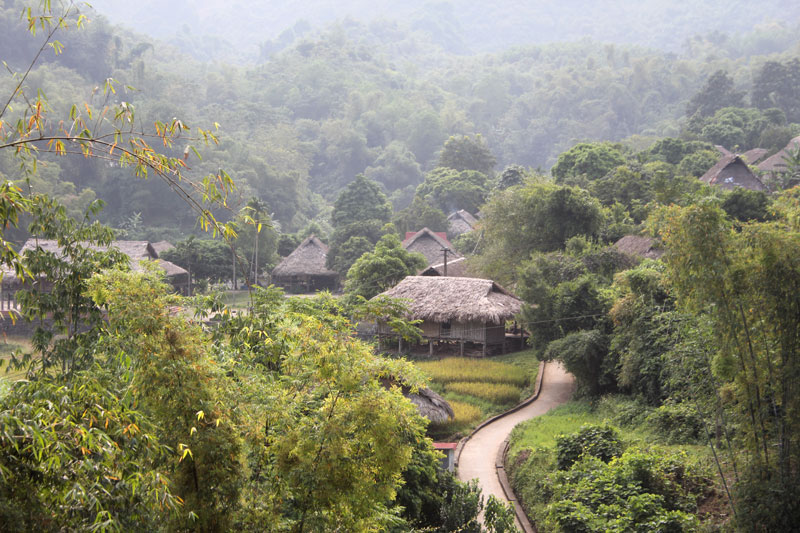
(HBO) - With advantages of natural conditions and cultural diversities of Muong, Thai, Mong, Dao ethnics, our province has many good conditions to develop community tourism. The community tourism has been developed quite early, which means that it gets some effective results and contributes in increasing the local people’s living conditions.

Giang
Mo Hamlet
in Binh Thanh commune (Cao Phong) attracts lots of tourists by over 100
original stilt houses and attractive cultural identities and customs of Muong
ethnic people.
Lac Hamlet of Chieng Chau
commune (Mai Chau) is one of the places which have developed the provincial
community tourism so early. When talking to us, Mr. Ha Cong Tim, the host of
the guesthouse No.7 in Lac tourist destination shared: With beautiful natural
scenery and long- lasting Thai ethnic culture, Lac Hamlet has been visited by
local and international tourists for a long time. But in 1993, the hamlet was
officially approved to carry out community tourism with 2 households. There
were up to 5 households in 1995 and 15 households in 1997. To meet the
increasing demand of visitors, by the end of 2016, the hamlet had 58 households
implementing community tourism. Lac tourist destination has been developing
better than the other ones. As an agricultural hamlet, people here are still
doing the farming, besides; making tourism services has changed their lives.
The face of the hamlet has been developed much more than before.
In the recent years, not
only in Lac hamlet but also in other remote areas, exploiting the potential of
ecotourism associated with cultural tourism has brought conditions to develop
economy and increase the income for many households and people. According to an
incomplete statistics, there are about 100 households in the province
developing homestay tourism. Many tourist destinations have been well-known and
highly appreciated such as Lac community tourist destination with
ASEAN-standard qualified guestrooms (according to the standards built and
announced in 2016 by member countries). In 2017, ASEAN tourist forum awarded
community- based tourism for Pom Coong, Mai Chau town; Mai Hich Homestay was
also won the ASEAN Homestay Award.
In the province, there are many other
community tourism destinations such as Ai Village of Phong Phu commune (Tan Lac)
which is known as the oldest
Muong
Village and preserves
traditional customs and interesting cultural identities of Muong ethnic group.
At the beginning of 2004, the village was approved as a community tourist
destination by the provincial People’s Council. In 2008, it was recognized as
the typical traditional village of Ethnic people by Ministry of Culture, Sports
and Tourism and was invented from the project "Renovating and preserving the
ancient Muong village”. Up to now, the traditional customs and cultural
identities of Muong ethnic in Ai village has been and bringing good feelings
for many visitors.
In Cao Phong district,
Giang
Mohamlet of Binh Thanh commune has attracted visitors with more than 100 stilt
house-roofs which are originally kept from the shape to the living way of
outstanding customs and culture of Muong ethnics. Da Bac upland district is
beginning to welcome local and international tourists in some communes such as
Da Bia, Tien Phong. It is the same with Vay Nua commune in Ke and Cao Son in
Sung. In Ngoi hamlet of Ngoi Hoa commune (Tan Lac), homestays in Ngoc Son – Ngo
Luong Natural Reserve still keep original cultural values of Muong ethnics
within the mountainous forests and romantic lakes, which attract many
international and local tourists to visit and experience.
Mr. Luu Huy Linh, Deputy Director of
the provincial Department of Culture, Sports and Tourism said: it can be
affirmed that the community tourism activities has contributed to preserve the
cultural values, spaces and actively contribute to creating jobs and improving
ling conditions of ethnic minorities in the province. In order to exploit the
potential of resources for developing community tourism, the following tasks
should be taken care of in the upcoming time:
Firstly, the mechanism and policies
of developing community tourism will be researched to build.
Secondly, the tourism infrastructure
plan and investment will be paid attention.
Thirdly, the human resources will be
focused on training to meet the requirements of community tourism; building a
tourism unique product in each community tourism destination. Besides, the
propaganda and promotion of the tourist destination images and attractions
should be done well.
A diverse chain of eco-tourism and resort destinations concentrated in Hoa Binh city and the districts of Tan Lac, Da Bac, and Luong Son… Along with the launch of several key high-quality resort tourism projects, these developments have reshaped the landscape and enhanced the appeal of Hoa Binh as a travel destination.
Boasting diverse terrain, a mild climate, and rich natural resources, Cao Phong district is increasingly asserting its place on Vietnam’s tourism map, attracting both domestic and foreign visitors. The district is renowned for its stunning landscapes, majestic mountains, a crystal-clear hydropower lake, and the unique cultural identity of local ethnic groups.
With its pristine landscapes, unique cultural heritage of Muong ethnic minority, and an expanding range of visitor experiences, Tan Lac district of Hoa Binh has fast become a captivating destination for both domestic and international tourists.
Until now, Sung village in Cao Son commune, Da Bac district remains the only Dao ethnic community in Hoa Binh province to develop a community-based tourism model. Beyond its untouched natural landscapes, cultural identity serves as the cornerstone attraction for visitors.
Alongside the diverse cultural identities of the Kinh, Muong, Tay, Thai, Dao, and Mong ethnic people, Hoa Binh province is also renowned as the "capital" of the northwestern Vietnamese cuisine, offering unique and distinctive dishes. At festivals, during Lunar New Year (Tet), or on significant family or community occasions, special dishes are prepared, leaving a lasting impression on visitors.
A Phong Linh (Yellow Tabebuia) flower garden in Thang village, Thach Yen commune, Cao Phong district is currently in full bloom, drawing a large number of visitors.



